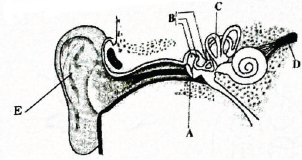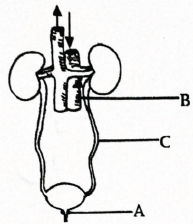Students can refer to the following Sample Paper ICSE Class 10 Biology Set E with Answers provided below based on the latest syllabus and examination guidelines issued for ICSE Biology. All specimen papers have been prepared covering all chapters given in ICSE Biology book for Class 10. You should also refer to ICSE Class 10 Biology Solutions.
Sample Paper ICSE Class 10 Biology Set E with Answers
BIOLOGY
Std : 10 Max. Marks : 80
No. of Questions : 07
Duration : 2 hours No. of Printed sides : 09
[Answers to this paper must be written on the paper provided separately.]
You will not be allowed to write during the first 15 minutes. This time is to be spent in reading the
Question Paper. The time given at the head of this paper is the time allowed for writing the answers.
The question paper has two sections 1 & 2. Attempt all questions from Section I and any four questions
from Section 2. The intended marks for questions or parts of questions are given in brackets [ ].
Sample Paper ICSE Class 10 Biology Set E
SECTION I (40 Marks)
(Answer all questions from this Section)
Question 1
(a) Name the following: [5]
(i) The inner concave margin of the kidney.
(ii) The category of blood vessels which have valves in their lumen.
(iii) The source of oxygen given out by plants during photosynthesis.
(iv) A natural phenomenon which sustains life on earth but becomes harmful due to pollution.
(v) The structure which connects the foetus to the placenta.
(b) Choose the correct alternative from the choices given below each statement so as to complete its meaning. Rewrite the completed statements. [5]
(i) The phytohormone, _____________ causes suppression of senescence.
(A) Gibberellins
(B) Cytokinins
(C) Auxins
(D) Abscisic Acid
(ii) The beating of the heart of man is heard on the left side, because _____.
(A) The left ventricle is towards the left side.
(B) Both ventricles are tilted towards the left side.
(C) Contraction of the heart is powerful on the left side.
(D) The dorsal aorta is on the left side.
(iii) When the vas deferens of a man is surgically disconnected or removed the ________.
(A) Semen will be without sperms.
(B) Sperms in the semen will be without nuclei.
(C) Spermatogenesis will not take place.
(D) Sperms in the semen will be non- motile.
(iv) A cell has five pairs of chromosomes. After mitotic division, the number of chromosomes in the daughter cells will be:
(A) Five
(B) Ten
(C) Twenty
(D) Forty
(v) Neurolemma is _________________.
(A) A thin layer of fatty substance surrounding the axon.
(B) The cell membrane around the nerve cell.
(C) The connective tissue around a nerve tract.
(D) A layer of specialized neuroglia around the myelin sheath.
(c) The diagram given below represents the growth of a stem of some germinating seeds A – E. The stem C was covered with an aluminium foil whereas D was covered with a clear plastic film. The stock of E was covered with a ring of metal.

Study the diagram and answer the questions that follow:
(i) Name the type of tropism shown above.
(ii) Explain why the stem of D shows movement but C does not.
(iii) Name the hormone responsible for the bending of the stem seen in A, D and E.
(iv) Name the hormone produced only by the roots and which gets distributed to the aerial parts of the plant through the xylem. State the main function of this hormone.
(v) Name the gaseous hormone produced by the plant and state its two functions.
(d) Give the exact location and function of the following: [5]
(i) Chloroplast
(ii) Corpus luteum
(iii) Papillary muscle
(iv) Corpus callosum
(v) Eustachian tube
(e) Given below are five sets of terms. In each case arrange and rewrite each set so as to be in a logical sequence. One is done as an example for you:
Eg.: Large intestine, stomach, mouth, small intestine, oesophagus.[5]
Ans: Mouth, oesophagus, stomach, small intestine, large intestine.
(i) Duramater, Cranium, Cerebrospinal fluid, Arachnoid, Piamater
(ii) Destarched plant, washed in warm water, iodine added, leaf boiled in alcohol, placed in sunlight.
(iii) Sister chromatids move towards opposite poles, chromosomes become thick and distinct, chromosomes line on the equatorial plane, chromatids thin out to form chromatin fibres.
(iv) Injury, clot, thrombokinase, thrombin, fibrin
(v) Epinephrine, Adrenal Medulla, increase in blood glucose level, glucose breakdown in muscles.
(f) Differentiate between the following: [5]
(i) Accommodation and adaptation (explain the processes)
(ii) Cerebrum and spinal cord (arrangement of neurons)
(iii) Lubb and dup (cause)
(iv) Homozygous and heterozygous (explanation)
(v) IAA and GA (expand the abbreviation)
(g) Explain the terms: [5]
(i) Evolution
(ii) Myocardial infraction
(iii) Polymerization
(iv) Plasmolysis
(v) Reflex action
(h) Give a reason for the following: [5]
(i) There is more frequent urination in winter than in summer.
(ii) People living in sub Himalayan regions generally suffer from simple goiter.
(iii) Some desert plants have leaves modified into spines.
(iv) Insulin is injected and not administered orally to diabetic patients.
(v) X linked diseases are more common in males than in females.
Sample Paper ICSE Class 10 Biology Set E
Section II
(Answer any four questions from this section)
Question 2
(a) Answer the following questions: [5]
(i) State two problems faced by India due to population explosion.
(ii) State two reasons why family planning has often failed in rural India.
(iii) Explain the terms:
(A) Population density
(B) Population growth
(iv) What are the effects of acid rain on plants and aquatic animals?
(v) State any two objectives of ‘Swachh Bharat Abhiyan’.
(b) The figure given below is a diagrammatic representation of a part of the cross section of the root in the root hair zone. Study the same and then answer the questions that follow:

(i) Name the parts indicated by the guidelines 1 to 4.
(ii) Which is the process that enables the passage of water and minerals from the soil into the root hair?
(iii) Name the pressure that is responsible for the movement of water in the
direction indicated by the arrows. Define it.
(iv) Name the collective name given for the movement of the solution in part labelled 3 and state how it is developed.
(v) Draw a neat labelled diagram of the root hair cell as it would appear if an excess of fertilizer is added to the soil close to it and state the condition of the cell.
Question 3
(a) The diagrams below represent certain physiological phenomena taking place in plants. Observe the diagrams and answer the questions that follow:

(i) Name and explain the process taking place in B.
(ii) Name any two plants in which A occurs.
(iii) Name and define the process seen in A.
(iv) State two ways on which the process B differs from the process of evaporation.
(v) Explain how humidity and rise in temperature affects the processes shown above.
(b) Study the diagram given below and answer the questions that follow:

(i) Name the type of blood vessel shown and explain its utility.
(ii) Name the cellular elements 1-4 seen in the cross section. State one structural and one functional difference between them.
(iii) Name the chemical produced by a cellular element, which causes the space between the endothelial cells to increase so that the process indicated by X is possible.
(iv) Name the process indicated by X.
(v) Name the process which can be observed in the diagram and explain its utility.
Question 4
(a) Study the diagram given below and answer the questions that follow:

(i) Explain the role of parts labelled A and B in the mechanism of hearing.
(ii) Name the specialized area from which the part labelled D arises.
(iii) Explain the function of the part labelled C.
(iv) What is the function of the part labelled E.
(v) Draw a neat diagram of the vertical section of the eyes and label the following parts.
(A) The structure that becomes uneven and due to which the image is blurred.
(B) The structure that maintains the shape of the eyeball.
(C) The aperture formed between the coloured extensions of the choroid.
(D) The area devoid of rods.
(b) Study the diagram given below and answer the questions that follow:

(i) Name and explain the physiological process being studied with the help of the experimental set up.
(ii) State the two aims of the experiment shown above.
(iii) Draw neat labelled diagrams of leaf X and Y after it has been tested for starch.
(iv) Draw a neat diagram of the organelle where the above seen process takes place and mark the areas where the phases of the process occur.
(v) A chemical substance NADP plays an active part in one of the phase. Give the expanded form of NADP and state its role in the above process.
Question 5
(a) Study the diagram given below and answer the questions that follow:

(i) Name the parts labelled A and B.
(ii) Why is the structure labelled D found in E?
(iii) Why is the structure labelled F cut and ligated?
(iv) Name the surgical procedure shown above and name a similar procedure carried out in females.
(v) Name a hormone released by the principal reproductive organ in
(A) Males
(B) Females
(b) With reference to evolution answer the following: [5]
(i) State two points of difference between Lamarckism and Darwinism.
(ii) Copy and complete the table given below.

(iii) Explain Industrial melanism.
(iv) Explain the terms
(A) Speciation
(B) Vestigial organs
Question 6
(a) With reference to the nervous system answer the following questions: [5]
(i) Draw a neat diagram of the motor neuron and label the following parts:
(A) The structure which receives the information.
(B) The structure which carries the information as electrical impulses.
(C) The structure that contains the neurotransmitter.
(D) The areas where the structure which acts as an insulating sheath is interrupted.
(ii) Copy and complete the table given below:

(b) In a garden pea plant, green coloured pea pod (GG) is dominant over yellow colour pea pod (gg). [5]
(i) What is the genotype of the F1 generation if a homozygous plant bearing green pea pods is crossed with a plant bearing yellow pea pods?
(ii) What is the genotypic and phenotypic ratio of the F2.
(iii) State the law of segregation.
(iv) Give the scientific name of the pea plant and state two reasons why Mendel chose this plant.
(v) What is mutation?
Question 7
(a) Study the diagram given below carefully and answer the questions that follow:

(i) State the function of A and C.
(ii) Explain why the blood vessel B carries the least amount of nitrogenous metabolic waste.
(iii) Draw a neat diagram of the renal corpuscle and label the two parts which help in developing a high hydrostatic pressure for ultrafiltration.
(iv) Explain why the renal cortex has a dotted appearance whereas the renal medulla has a striated pyramid region.
(v) Explain why only 1.2 litres of urine is produced when the nephrons produce 160 litres of glomerular filtrate.
(b) With reference to cell division answer the following: [5]
(i) State two points in difference between mitosis seen in a plant and in an animal cell.
(ii) Why is interphase necessary in a cell cycle?
(iii) Where does meiosis take place in animals and plants?
(iv) What is crossing over?
(v) Draw a neat labelled diagram of an animal cell with four chromosomes during anaphase.